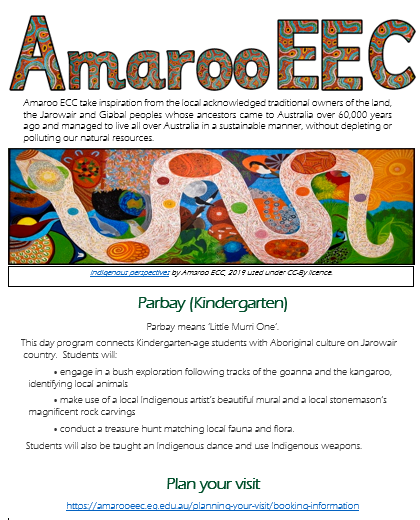6 Jarowair and Giabal experience
Taylor Deacon

Download the resource: Deacon resource
Amaroo Environmental Education Centre (EEC) designs, promotes and delivers highly effective environmental and Indigenous education programs for schools P-12 and for the community, including providing professional development for teachers (Department of Education, 2020). This resource can be used for educators to build their knowledge, adapt the learning resources, and focus on environmental sustainability and Indigenous perspectives relevant to the traditional owners of the land they live on. This resource provides hands-on learning and resources for teachers and educators to implement into their daily practices aligning closely with the Queensland Kindergarten Learning Guidelines and the Australian Curriculum. Educators can use this resource to build connections with their local community and build a stronger understanding of the Indigenous culture of the traditional owners of the land supporting children to promote greater understanding of Aboriginal ways of knowing and being (DEEWR, 2009). Amaroo EEC is a great resource for local Indigenous children as the teachers providing the program have strong knowledge of the Jarowair and Giabal cultures and are able to provide better learning opportunities for students and teachers.
It has been recognised that children from Aboriginal and Torres Strait Islander cultures respond and learn with storytelling, a traditional method of passing down knowledge (Price, 2012). Through this learning activity, teachers and educators from Amaroo use learning activities, language and music as they become co-learners with the children to build upon their prior knowledge, and relate what they are learning to their environment and community.
Lastly, Amaroo Environmental Education centre uses knowledge and understanding from the perspectives of traditional people of the Jarowair and Giabal peoples land to provide quality environmental and Indigenous education programs for students and teachers, encourage respect and responsibility for self, others and Country and empower active and informed citizens for a sustainable world co-cooperation learning and socialisation (Department of Education, 2020). This resource is beneficial to source local knowledge and stories that are actually meaningful and within a context that local Indigenous children understand.
Links
Early Years Learning Framework (DEEWR, 2009)
- Outcome 1: Children have a strong sense of identity
- 1.3 Children develop knowledgeable and confident self identities
- 1.4 Children learn to interact in relation to others with care, empathy and respect
- Outcome 2: Children are connected with and contribute to their world
- 2.1 Children develop a sense of belonging to groups and communities and an understanding of the reciprocal rights and responsibilities necessary
for active community participation.4 broaden their understanding of the world in which they live - 2.2 Children respond to diversity with respect
- 2.4 Children become socially responsible and show respect for the environment
- 2.1 Children develop a sense of belonging to groups and communities and an understanding of the reciprocal rights and responsibilities necessary
- Outcome 5: Children are effective communicators
- 5.3 Children express ideas and make meaning using a range of media

